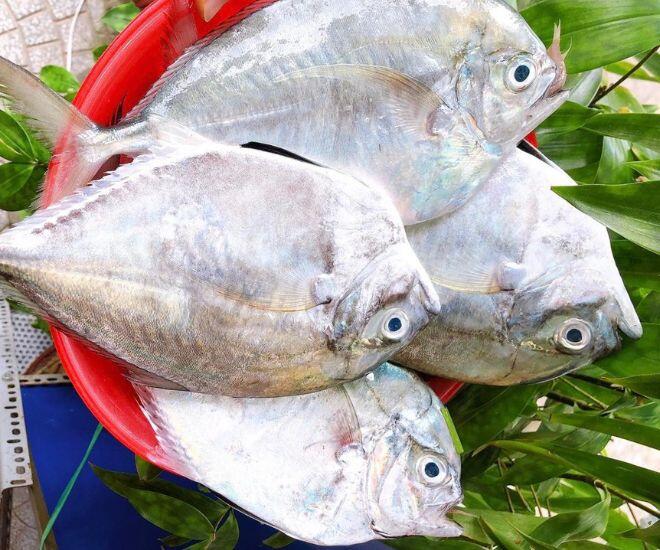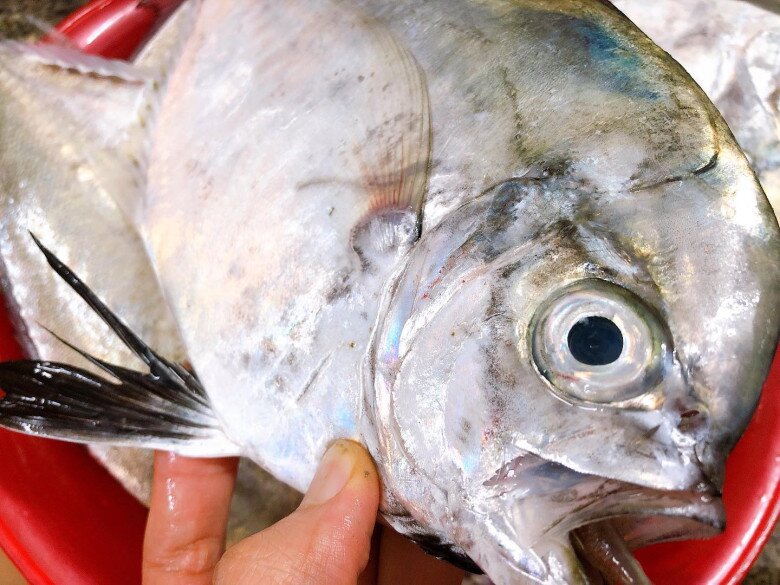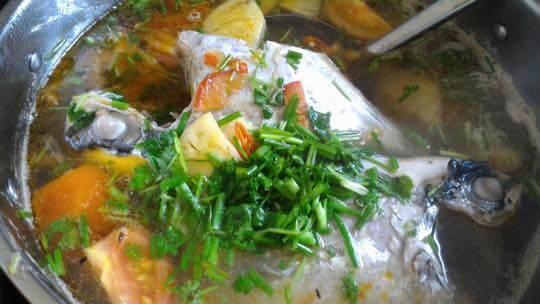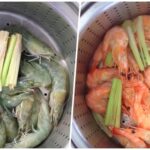
Compassion fish, locally known as “cá bi,” boasts a distinctive appearance compared to many other marine species. Its shape resembles that of a distant fish but with a thicker body and a rounder head, exuding a robust impression. The fish’s back is dark green, seamlessly blending with the ocean’s hue when viewed from above, while its belly shines with a silvery-white, smooth luster. Notably, its skin is entirely scaleless and remarkably sleek.
On average, compassion fish are about the size of an adult’s hand or slightly larger, with thick, firm, and aromatic flesh. They inhabit the seas a few nautical miles from the shore, where the waves and winds constantly caress them. This natural environment imparts a unique quality to their meat: sweet, rich, nutty, and with minimal fine bones, making it suitable for both children and the elderly.
Unlike many other fish species that can be caught with bait, compassion fish do not take to conventional lures. As a result, fishermen cannot use traditional fishing methods and must rely on casting nets. Typically, near-shore fishing boats release their nets in the late afternoon or evening, only to retrieve them the next morning in hopes of a catch.
However, the yield from each trip is often modest. Fishermen consider catching even a few compassion fish a significant success. This scarcity contributes to its status as a rare and valuable delicacy compared to other seafood. Recent reports indicate that compassion fish are sold on online marketplaces for approximately 200,000 VND per kilogram. Despite the price, many are eager to try it out of curiosity for its unusual name and distinctive flavor.

What sets compassion fish apart is its mild sweetness, thick white flesh, lack of fishiness, and minimal bones. When prepared, it retains the fresh, briny essence of the sea, leaving a lasting impression on first-time diners.
According to locals, compassion fish is commonly prepared in three ways: steamed, boiled, and grilled. Each method highlights a unique aspect of the fish, showcasing the culinary finesse of Central Vietnam’s seafood traditions.
Steamed: After cleaning the gills, fins, and thoroughly washing the fish, it is placed in a steamer. This method requires precision, as overcooking can make the flesh mushy and diminish its natural sweetness. Steamed fish is often served plain, without additional seasoning, and paired with rice paper rolls filled with fresh vegetables and dipped in garlic chili fish sauce. This approach preserves the fish’s freshness, offering a rich yet non-greasy experience. Some families enhance the dish by adding shiitake mushrooms, pineapples, and scallions, serving it with vermicelli or rice paper for a more nutritious and flavorful meal.
Boiled: Boiled compassion fish is seasoned with a touch of salt, chili, and herbs. The broth can be enjoyed as a clear, sweet soup, accompanied by crispy rice paper crumbles. The fish’s white, fragrant flesh remains tender and non-greasy, while the broth provides a refreshing, soothing sensation, ideal for hot summer days.
Grilled: Grilling is perhaps the most beloved preparation method. After cleaning, the fish is placed on a charcoal grill, frequently turned to ensure even cooking. As it cooks, the fish releases a tantalizing aroma, blending the salty sea breeze with the smoky scent of charcoal, evoking a sense of rustic charm. Grilled fish can be enjoyed on its own or wrapped in rice paper with fresh herbs, dipped in spicy fish sauce. This method perfectly preserves the fish’s sweetness and richness.
Beyond these three main dishes, compassion fish can also be used in sour soups with ingredients like tomatoes, pineapples, and mint. The tangy broth complements the fish’s natural sweetness, creating a harmonious and irresistible flavor profile.

Compassion fish is not only a staple in family meals but also a favorite for entertaining guests. Locals often pair it with special beverages like seafood-infused liquor (made from sea coconuts or seahorses) or cold beer. This combination enhances the flavors and provides a more complete dining experience.
In recent years, as the demand for regional specialties has grown, compassion fish has become a sought-after delicacy. It is now featured in high-end seafood restaurants as well as in simple home-cooked meals, bridging the gap between the ocean’s essence and everyday dining.
With its natural sweetness, thick, aromatic flesh, compassion fish is rightfully considered one of Central Vietnam’s signature delicacies. Despite its limited availability and higher price, its unique flavor and cultural significance have made it increasingly popular.
From family dinners to formal gatherings, compassion fish holds a special place. It is not just a delicious dish but also a cultural symbol and a source of pride for the fishermen of Binh Thuan and the people of Central Vietnam. For anyone exploring Vietnamese regional cuisine, compassion fish is a must-try, offering a true taste of the country’s maritime essence.
































